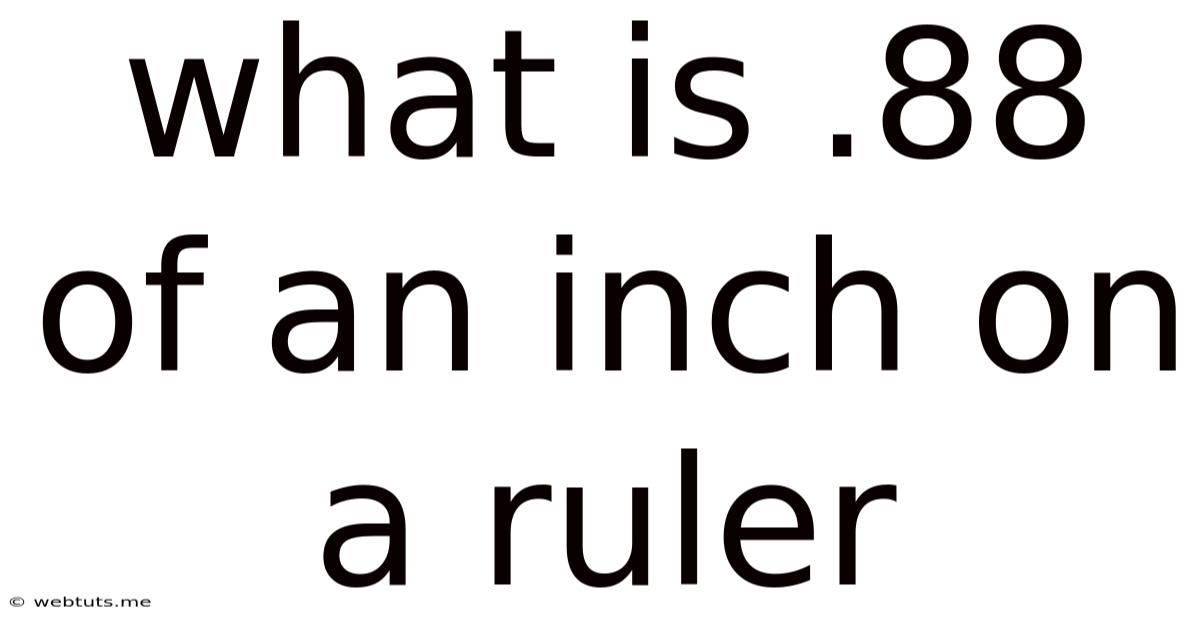What Is .88 Of An Inch On A Ruler
Webtuts
May 11, 2025 · 4 min read

Table of Contents
What is .88 of an Inch on a Ruler? A Comprehensive Guide
Measuring accurately is crucial in various fields, from woodworking and sewing to engineering and design. Understanding fractional measurements, especially those expressed as decimals, is essential for precision. This article delves deep into the question: "What is .88 of an inch on a ruler?" We'll explore different ways to represent this measurement, explain how to locate it on a standard ruler, and discuss its practical applications.
Understanding Decimal Inches
Before we pinpoint .88 of an inch, let's review the basics of decimal inches. A standard inch is divided into 16ths, 32nds, or even 64ths on most rulers. However, decimal inches represent fractions of an inch using decimal points. Instead of expressing it as a fraction like 7/8, we use its decimal equivalent, which in this case is 0.875. Understanding this conversion is key.
Converting Fractions to Decimals
Many people find it easier to visualize fractions. To find the decimal equivalent, simply divide the numerator (top number) by the denominator (bottom number). For example:
- 1/2 inch = 0.5 inch (1 divided by 2)
- 3/4 inch = 0.75 inch (3 divided by 4)
- 7/8 inch = 0.875 inch (7 divided by 8)
You can use a calculator or online conversion tool to easily perform these calculations. This knowledge is vital when working with rulers that don't have markings for every 1/64th of an inch.
Locating .88 of an Inch on a Ruler
Now, let's tackle the specific question: Where is .88 of an inch on a standard ruler? Since most rulers don't have a marking for precisely .88 inches, we need to approximate.
The Closest Fraction: 7/8 Inch
As we established earlier, 7/8 of an inch is equivalent to 0.875 inches. This is incredibly close to 0.88 inches. The difference is only 0.005 inches, a minuscule amount barely visible to the naked eye on most standard rulers. Therefore, for all practical purposes, 0.88 inches is virtually identical to 7/8 inches on a ruler.
Visualizing the Measurement
Imagine your ruler. Find the 7/8 inch marking. This is your practical equivalent for 0.88 inches. It's located just a tiny bit before the 1-inch mark. You can use this as your reference point.
Using a Vernier Caliper for Precision
If extreme precision is needed, a vernier caliper is the tool of choice. A vernier caliper allows for measurements to a much higher degree of accuracy than a standard ruler. It can easily pinpoint 0.88 inches with precision.
Practical Applications of .88 Inch Measurements
The seemingly insignificant difference between .875 inches (7/8) and .88 inches has practical implications in specific scenarios:
Engineering and Manufacturing
In precision engineering, even minor discrepancies can matter. While 7/8 inch might be suitable for many applications, a project requiring extreme accuracy might necessitate the use of a vernier caliper to measure precisely 0.88 inches.
Woodworking and Carpentry
Woodworkers often deal with fractional measurements. While 7/8 inch is a common size, understanding how close .88 inches is to this standard allows for better material planning and accurate cuts.
Sewing and Tailoring
In sewing and tailoring, tiny discrepancies in measurements can impact the final product. While the difference is negligible in many cases, projects requiring exact dimensions necessitate the use of precise measurements, and a vernier caliper may come in handy.
Other Applications
Various other fields require accurate measurements. These include:
- Electronics: Designing and assembling circuit boards often requires precise measurements.
- Printing: Accurate dimensions are crucial in print design and layout.
- Construction: While less critical in many cases, precise measurements ensure proper fitting of components.
Beyond the Ruler: Digital Measurement Tools
In today's digital world, advanced measurement tools provide enhanced accuracy and efficiency.
Digital Calipers
Digital calipers offer a significant advantage over traditional rulers. They display measurements digitally, eliminating guesswork and providing greater precision. Digital calipers can measure .88 inches with ease.
Laser Measurement Tools
For larger distances, laser measurement tools offer exceptional accuracy. They are particularly useful in construction and surveying.
Troubleshooting Common Measurement Challenges
Measuring accurately can be challenging. Here are some common issues and their solutions:
- Eye Strain: Ensure good lighting. Using a magnifying glass for finer details can significantly enhance accuracy.
- Ruler Alignment: Maintain proper alignment of the ruler to the object being measured to prevent inaccurate readings.
- Parallax Error: Position your eye directly above the measurement point to avoid parallax error (an apparent shift in an object's position due to a change in viewing angle).
Conclusion: Mastering Decimal Inches
Understanding decimal inches, and specifically how to interpret and locate measurements like 0.88 inches, is crucial for precision in numerous fields. While a standard ruler might not have a specific marking for 0.88 inches, understanding its close proximity to 7/8 inches and utilizing tools like vernier calipers or digital measuring devices ensures accuracy. This knowledge allows for better material planning, precise cuts, and ultimately, higher-quality results in various applications. Mastering decimal inches empowers you to work with greater precision and confidence. Remember to always use appropriate tools for the level of accuracy required for the task at hand.
Latest Posts
Latest Posts
-
How Many Kilos In 50 Lbs
May 12, 2025
-
How Many Days To May 23
May 12, 2025
-
How Long Until The 4th Of July
May 12, 2025
-
How Many Days Until July 6 2025
May 12, 2025
-
What Day Is In 70 Days
May 12, 2025
Related Post
Thank you for visiting our website which covers about What Is .88 Of An Inch On A Ruler . We hope the information provided has been useful to you. Feel free to contact us if you have any questions or need further assistance. See you next time and don't miss to bookmark.